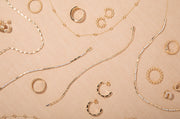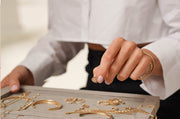Do you ever gaze at something beautiful - like jewelry - and wonder how something so gorgeous was actually created? We’re all about the behind the scenes scoop! A jewelry piece’s stone is usually the leader of conversation — there is something about stunning sparkle that’s a natural conversation starter, we get it. However today we’re going to hone in on the backbone of the creation: the precious metal, specifically, white gold. We’ll explore what white gold is, its unique properties and why it’s such a popular, reliable jewelry choice!
How White Gold Is Made & The Creation Process
Before we dive in, it’s important to have a clear sense of a few VIP words as they come up a lot when discussing metal.
a substance composed of two or more metals
White gold is made by alloying (mixing) natural, 24 karat yellow gold with other metals which results in a white colored metal: white gold.
Jewelers use different alloy metal mixtures which lead to:
- Various Purities (10 karat, 14 karat, 18 karat)
- Variable White Tones
- Different Levels of Hardness
White gold is a blend of:
- Pure, 24k yellow gold
- White Metals, i.e.: nickel, palladium, zinc or silver
The 14k white gold creation process begins with pure, 24k yellow gold that is alloyed with white metals. The pure, yellow gold is melted and the alloyed metals are gradually added to the melted gold. Once the alloy is thoroughly mixed, it’s then cast into molds to create white gold jewelry components.
Comparing Yellow White Gold and Silver
The composition of white gold, yellow gold and silver all differ because they’re different alloys (mixtures).
White Gold vs Yellow Gold
White gold is an alloy of pure gold and white metals which leads to the silvery-white color. Yellow gold is an alloy of pure gold and silver or copper which produces the traditional, warm yellow color. So, the main difference between white gold vs yellow gold is the types of alloy metals added and the final color of the gold.
White Gold vs Silver
Silver’s composition is an alloy of sterling silver and copper which creates a bright white color. So while the difference in white gold vs silver may not be super visual, the composition is very different, with silver containing no gold alloy.
Silver/Yellow Gold/White Gold Strength Rating (from hardest to softest):
- White Gold
- Yellow Gold
- Silver
Why Are Alloy Metals Added to White Gold?
Alloy metals are added to white gold to enhance its properties and achieve the desired color and durability. For instance, 18k white gold, made by alloying pure yellow gold with metals such as nickel, palladium, or silver, gains a distinct white hue and improved strength. Alloy metals not only alter the gold color to a white metal appearance but also enhance the resilience of the gold jewelry, making it suitable for fine jewelry pieces like white gold engagement rings and white gold necklaces. This process helps maintain the gold content while reducing the likelihood of tarnish, ensuring that white gold jewelry pieces retain their elegance and durability over time.
Benefits of Choosing White Gold for Jewelry
Because white gold is very strong, it’s popular in modern jewelry not only because of the alluring color but also because of the durability!
The white alloy color is also highly desirable because it makes white diamonds appear even whiter and more radiant!
Dana loves white gold - check out her faves! Friendly reminder that it’s ok to mix things up - yellow and white gold look COOL worn together!
Gentle Cleaning Remedies for White Gold
- Good old soap and water! This method is classic and efficient – sometimes the most simple methods work best! Our favorite jewelry cleaning cocktail is: warm water, gentle dish soap and a soft toothbrush. A brush is extra important as it’s a safe way to get in between small cracks where gross things like to nestle.
- A jewelry cleaner - like the DRD Jewelry Cleaner - also works, but there needs to be something to move the dirt away, that’s why a soft toothbrush is great. Combine water with the contents of one DRD cleanser pod in the eco-friendly jar, immerse your jewels in the solution, let rest for five minutes, then scrub with the gentle brush (that’s included) to remove any gunk, rinse, and blot dry with a soft cloth! The solution is good for several uses; however, we recommend changing out the water once it becomes murky. The system comes with two cleanser pods. [Please note this cleanser is not safe to use on pearls, soft stones or other gemstones].
- We also offer our Jewelry Dish and Cleaner Set that comes with our cleaning solution! Everyone needs a trinket tray to store their favorite everyday jewels!
Reminders:
The gym is good for the mind/body and tough on jewels. Weight lifting, tightly gripping the handles of an elliptical, pressing your hands into the floor as you finally achieve that perfect handstand - these are all situations that can warp the metal of a white gold ring. Our Travel Jewelry Zip Case is great to have on hand when you need to take your beloved rings off for their own protection!
The #1 place where jewelry gets lost is in water (pools, oceans and lakes)! Plunging into water or even hitting a surprise wave can easily remove jewelry from a slippery body. Skin naturally shrinks in water, which causes jewelry to fit much looser.
Mistakes to Avoid When Cleaning White Gold
- Steer clear of harsh chemicals like bleach, chlorine, and acetone. These substances can weaken the white gold. Similarly, avoid abrasive cleaners such as powdered cleaners and toothpaste, as they can erode the white gold and alter the color.
- Use only soft brushes while cleaning as stiff-bristled or abrasive cleaning tools can scratch the white gold.
- Be mindful of thick lotions and creams. These can leave a residue on your white gold, making it appear dirty and
- potentially leading to discoloration.
Fun Fact: White gold does NOT tarnish. However, nature is clever and has a way of wanting things to return to their natural state (which for white gold would be yellow gold). Modern metallurgy and technology has made current white gold alloys brighter and less susceptible to discoloration and fading.
Understanding Hallmarks and Purity Marks
Each mark/inscription on metal jewelry is there on purpose.
The National Gold and Silver Marking Act of 1906 mandates that jewelers manufacturing gold jewelry in the United States are required to mark their product with a karat stamp to indicate purity as well as the registered trademark of the person verifying it. It’s a great idea to check for that mark when inspecting your white gold!
As always, DRD wants you to not only enjoy learning about how metals are made, but also the process of choosing which metal to go with when it comes to your jewels! The DRD team of GIA certified specialists are always available to answer any questions and happy to walk you through options in order to make the best metal choice. It’s also hard to go wrong — if you love the look of white gold one day and are in the mood for yellow gold the next day, we love mixing metals! Rock your jewels proudly!


















